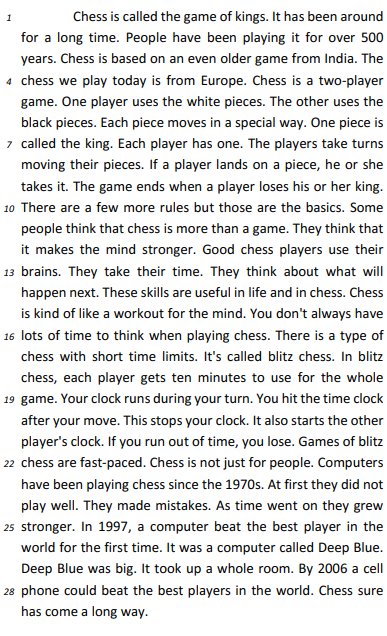Choose the alternative that presents extracts from the text ...

Internet: <www.nortechplus.com>.
- Gabarito Comentado (1)
- Aulas (4)
- Comentários (5)
- Estatísticas
- Cadernos
- Criar anotações
- Notificar Erro
Gabarito comentado
Confira o gabarito comentado por um dos nossos professores
Present Perfect é formado pelo verbo auxiliar to have (have/has) conjugado no Simple Present (presente simples) + o Past Participle (particípio passado) do verbo principal.
A alternativa C está nos tempos solicitados no enunciado. A forma “made" é a conjugação no simple past do verbo irregular “make".
C) Correta - “They made mistakes." (line 24); “Chess sure has come a long way." (lines 28 and 29)
“Eles cometeram erros." (linha 24); “O xadrez certamente percorreu um longo caminho." (linhas 28 e 29)
Gabarito: C
Clique para visualizar este gabarito
Visualize o gabarito desta questão clicando no botão abaixo
Comentários
Veja os comentários dos nossos alunos
Marquei correto devido o auxiliar has porém a primeira frase me deixou em dúvida
GABARITO C
Gab. C
c-
In the labyrinthine terrain of temporal articulation, the simple past, an artifact of linguistic predilection, materialises as a crystalline vessel wherein the vicissitudes of a given entity's chronological peregrination attain an arrested state. Imagine, if you will, an intricate ballet choreographed by the flux of existence. In this intricate ballet, a singular and finite episode, denoted as Event X, becomes ensconced within the continuum of temporal flux.
In the instantiation of the simple past tense, the temporal narrative refracts, congealing the narrative milieu into a tableau wherein the protagonist, akin to a metronome of temporal cadence, undergoes a transitory state from an anterior state of non-swimming to a subsequent state of having swum. It is, therefore, a semantic decantation wherein the undulating fluidity of contemporaneous temporality metamorphoses into a stilled vignette, akin to a painting meticulously forged upon the canvas of linguistic expression, encapsulating the quintessence of the transpired instance within the recesses of antiquated linguistic morphology.
LETRA C
Clique para visualizar este comentário
Visualize os comentários desta questão clicando no botão abaixo